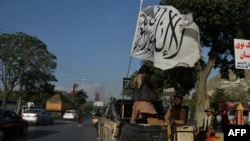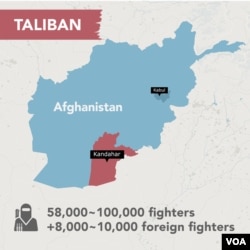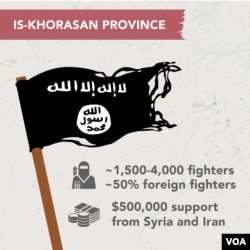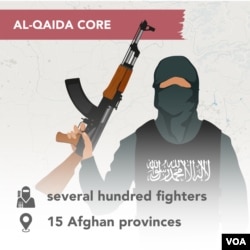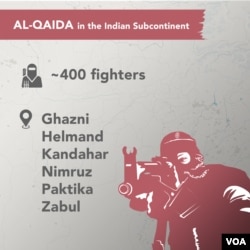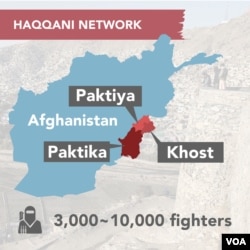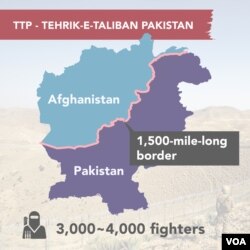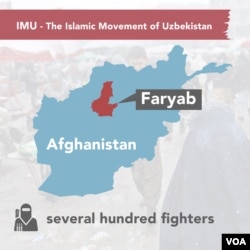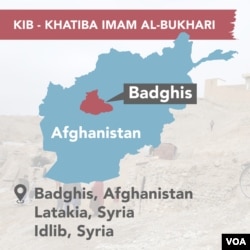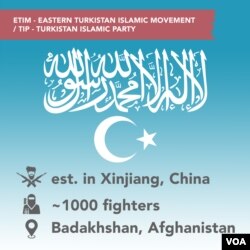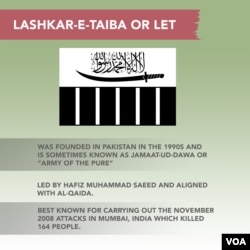A year after the last U.S. troops left Kabul, there appears to be little consensus on whether the world, and the West in particular, is any safer from the terrorist groups that call Afghanistan home.
One of the most polarizing developments in the debate came on July 31 of this year, when a U.S. airstrike — the first in Afghanistan since U.S. forces departed on August 30, 2021 — targeted a safe house in downtown Kabul, killing al-Qaida terror group leader Ayman al-Zawahiri.
U.S. officials said al-Zawahiri had moved to the Afghan capital months earlier, residing in a house owned by members of the Taliban’s ruling coalition and that Taliban officials were aware he was there.
"The United States does not need a permanent troop presence on the ground in harm’s way to remain vigilant against terrorism threats or to remove the world’s most wanted terrorist from the battlefield,” White House National Security Council spokesperson Adrienne Watson wrote in a memo issued Monday.
A recently declassified U.S. intelligence assessment also downplays the threat from al-Qaida in Afghanistan.
Al-Qaida in particular “does not have a capability to launch attacks against the U.S. or its interests abroad from Afghanistan,” according to the assessment, which added that the group “has not reconstituted its presence in Afghanistan since the U.S. departure in August 2021.”
But there are skeptics of the view that al-Qaida has been diminished, including some U.S. lawmakers and former U.S. military and intelligence officials, who argue al-Zawahiri’s presence in Kabul should renew fears that the Taliban would fail to adhere to promises codified in the 2020 Doha agreement with the United States, including severing ties with al-Qaida.
And it is not just a potentially resurgent al-Qaida that has raised concerns among counterterrorism agencies around the world.
A U.N. report issued last month warned the Islamic State terror group affiliate in Afghanistan was expanding, and that IS core leadership now “views Afghanistan as a base for expansion in the wider region for the realization of its 'great caliphate' project."
The same report argued that al-Qaida may be better positioned to emerge as the greatest long-term terror threat.
“I think we are on the same precipice of concern about state collapse that could lead to the rise or the empowerment of transnational terrorist organizations," Republican Representative Peter Meijer said in prerecorded remarks Monday to the Center for Strategic and International Security, likening conditions in Afghanistan now to those that existed prior to the September 11, 2001, terror attacks in the United States.
“We have a vested interest today in making sure that Afghanistan does not collapse, that there is not an overwhelming humanitarian catastrophe that will only empower those who seek to do the West harm," Meijer added.
And even U.S. intelligence officials have refused to rule out that al-Qaida, or IS, in particular, could one day move to strike the West.
Earlier assessments suggested that could happen in as little as six months to a year, but newer reports suggest it will still take both terror groups about a year to rebuild external attack capabilities, should they decide to do so.
Here is a look at the Taliban and the major terrorist organizations now operating in Afghanistan, and how they have fared in the year since U.S. and coalition forces left the country.
Click on the name of the organization to jump to that section, or scroll to read them in order.
Islamic State Khorasan Province
Al-Qaida in the Indian Subcontinent
The Islamic Movement of Uzbekistan
Eastern Turkistan Islamic Movement/Turkistan Islamic Party
Since its emergence in 1994, the Taliban movement, which calls itself the Islamic Emirate of Afghanistan, has been led by an emir, a central figure ostensibly appointed for life by a religious council of Taliban leaders.
Like his two predecessors, current emir Hibatullah Akhundzada has made few public appearances and leads a reclusive life in southern Afghanistan's Kandahar province.
Initial intelligence assessments indicated Akhundzada had been leaving management of day-to-day government affairs to his appointed caretaker Cabinet in the Afghan capital. But newer intelligence from several countries indicates things have been changing.
"Outsiders’ access to the Taliban leader is limited, and Hibatullah himself has reportedly been less open to deliberation with other Taliban leaders with whom he previously held regular consultations," the United Nations concluded in a report in May, based on member state intelligence.
Akhundzada "is said to have become more autocratic and dismissive of dissent," the report added.
There are also signs that the Taliban under Akhundzada are still working to consolidate power.
“The Taliban have been shifting to what I would call calculated coercion, using not as little violence as possible, but selectively applying and targeting violence. That's both in a military sense and in a social sense in terms of repression, of political opposition of dissenting speech,” Andrew Watkins, a senior expert with the U.S. Institute of Peace, told an online forum hosted Tuesday by the CATO Institute.
Various estimates by U.S. intelligence agencies and U.N. member states put the number of Taliban fighters between 58,000 and 100,000, with numbers fluctuating according to the time of year and battlefield conditions.
Intelligence assessments shared with the U.N., however, suggest the Taliban are seeking to increase the size of their standing military to as many as 350,000 fighters. As of May, it was believed 7,000 new recruits had completed training.
The Taliban are also trying to nurture a nascent air force, with 40 operational aircraft captured from the former U.S.-backed Afghan military. The list of aircraft includes two Russian-made Mi-17 helicopters, two U.S.-made Black Hawk helicopters, two Mi-24 helicopter gunships and a transport plane.
Intelligence shared publicly by the U.S. and U.N. member states further accuses the Taliban of continuing to work closely with al-Qaida and maintaining ties with other terrorist groups, pushing some to become part of a new Taliban-run Afghan military force.
For their part, Taliban officials have publicly denied that terrorism is an issue for Afghans under their leadership and recently claimed they had “no knowledge” that al-Zawahiri was living in Kabul.
U.S. officials are skeptical.
"We have reason to believe — very good reason to believe — that members of the Taliban, Haqqani network, were aware of his [al-Zawahiri's] presence in Kabul,” State Department spokesperson Ned Price said Monday. "And we are taking a look at the implications of that."
Recent intelligence shared with the U.N. also suggests the Taliban are looking for ways to confront Islamic State’s Afghan affiliate, Islamic State Khorasan Province, or IS-Khorasan.
Reports indicate the Taliban have set up three special forces battalions to take on IS-Khorasan, with one of the battalions boasting 1,000 fighters.
Islamic State Khorasan Province
IS-Khorasan is a sworn enemy of both the Taliban and al-Qaida, which has deep and long-standing ties to Taliban leadership. But IS-Khorasan is also one of the terror groups that has benefited the most from the Taliban takeover.
As Taliban forces quickly took control of Afghanistan last year, they emptied numerous prisons and allowed IS-Khorasan fighters to escape. At the time, U.S. military officials cautioned that the prison breaks allowed the terror group’s numbers to swell from several hundred fighters to a couple thousand.
More recent assessments from the U.S. and the U.N. now put the size of IS-Khorasan at between 1,500 and 4,000 fighters, concentrated mostly in remote parts of Kunar, Nangarhar and Nuristan provinces.
Some intelligence agencies also argue there is evidence of smaller, covert IS-Khorasan cells spread across the northern Afghan provinces of Badakhshan, Faryab, Jowzjan, Kunduz and Takhar.
“I think the threat of Daesh is growing,” former Afghan national security adviser Hamdullah Mohib told VOA’s Afghan Service, using the Arabic acronym for the terror group.
The Taliban “are incapable of preventing Daesh attacks, and in fact, their recruitment has been on the rise,” Mohib said. “Members of the Taliban perhaps have also joined Daesh as retaliation to maybe some of their policies and other grievances that they would have with their leadership.”
Recent intelligence shared with the U.N. indicates the Taliban are having difficulties putting pressure on IS-Khorasan, and that some efforts may backfire.
Reports also suggest that in addition to disgruntled former Taliban fighters, IS-Khorasan has also attracted some former members of the U.S.-backed Afghan military who fear retaliation from the ruling Taliban government.
The pace of IS-Khorasan attacks also seems to have increased, with the group claiming rocket attacks against targets in Pakistan and Uzbekistan, and also increased activity along the border with Tajikistan.
“I think they're really trying to establish that they are not just confined to Afghanistan. They have broader aims, regional aims, as well,” Asfandyar Mir, a senior expert at the U.S. Institute of Peace, told VOA in June.
But Mir doubts that for now, IS-Khorasan is prepared to expand its footprint.
IS-Khorasan leader Sanaullah Ghafari, also known as Shahab al-Muhajir, “doesn't believe in holding territory. He seems to think that holding territory is costly, and so he doesn't want to do that,” Mir said. "I think their primary focus will remain Afghanistan. They will continue to attack these religious minorities and then make a real effort to target Taliban leaders.”
Earlier this month, IS-Khorasan claimed an attack that killed one of those leaders, Talban cleric Sheikh Rahimullah Haqqani.
Officials from the U.S. and other countries have said there are no signs IS-Khorasan is planning to conduct attacks against the West, and that it could take until early next year for the group to muster the needed capabilities.
But a U.S. official speaking to VOA on the condition of anonymity in order to discuss intelligence warned the timing depends on IS-Khorasan’s political calculations.
The official said should IS-Khorasan decide to make attacks against the West or the U.S. a priority, it could do so more quickly.
Intelligence assessments from a number of countries shared with the U.N. in the months after the Taliban takeover of Afghanistan suggested al-Qaida was enjoying "a significant boost" from the withdrawal of U.S. forces.
And an updated U.N. report written before al-Zawahiri was killed on July 30 said he was “alive and communicating freely.”
The report further warned that, “the international context is favorable to al-Qaida, which intends to be recognized again as the leader of global jihad.”
But al-Qaida’s fortunes appear to have taken a major downturn following the July 30 strike that killed al-Zawahiri.
A newly declassified U.S. intelligence community assessment, highlights of which were shared with VOA, rejects the notion that the al-Qaida core is building momentum, despite a historically cozy relationship with the Taliban.
“Al-Qaida has not reconstituted its presence in Afghanistan since the U.S. departure in August 2021,” according to the assessment, first reported by The New York Times.
“Ayman al-Zawahiri was the only key al-Qaida figure who attempted to reestablish their presence in country when he and his family settled in Kabul earlier this year,” the assessment continued. “Less than a dozen al-Qaida core members with historical ties to the group remain in Afghanistan and probably were located there prior to the fall of Kabul; we have no indication that these individuals are involved in external attack plotting.”
Still, intelligence from other countries that was shared with the U.N. would suggest that while al-Qaida may not present an immediate threat, there is reason for concern.
“Al-Qaida leadership reportedly plays an advisory role with the Taliban, and the groups remain close," last month’s U.N. report cautioned. "Al-Qaida propaganda is now better developed to compete with [Islamic State] as the key actor in inspiring the international threat environment, and it may ultimately become a greater source of directed threat."
But there are questions as to whether Afghanistan will continue to play a prominent role in incubating al-Qaida and its larger aspirations.
Current and former Western counterterrorism officials say expectations that the Taliban takeover of Afghanistan would spur a migration of al-Qaida followers to the country appear to have fizzled out.
So, too, none of al-Zawahiri’s likely replacements are currently in Afghanistan.
Al-Zawahiri’s No. 2, Saif al-Adel, is in Iran, where he has been for several years.
“He’s in Iran ... do the Iranians let him leave?” said a former Western counterterrorism official, who spoke to VOA on the condition of anonymity in order to discuss classified intelligence. “It’s sort of tough to be the leader of al-Qaida while stuck in a gilded cage.”
Al-Qaida’s No. 3, Abd al-Rahman al-Maghrebi, is likewise thought to be in Iran. And the next two in line to lead al-Qaida are in Africa: Yazid Mebrak, al-Qaida in the Islamic Maghreb (AQIM) leader, and Ahmed Diriye, leader of al-Shabab.
As for the al-Qaida officials still in Afghanistan, U.S. intelligence agencies are skeptical they could muster a substantial threat.
“We assess that neither the few remaining al-Qaida core members, nor its regional affiliate, are plotting to attack the Homeland,” the recently declassified intelligence assessment concluded. “Al-Qaida has several affiliates we believe it would call upon outside the region to drive potential plots.”
Al-Qaida in the Indian Subcontinent
One of al-Qaida's key offshoots, al-Qaida in the Indian Subcontinent (AQIS), appears to now have a greater presence in Afghanistan than the group's core.
Intelligence estimates from U.N. member states say AQIS has up to 400 fighters in Afghanistan spread across Ghazni, Helmand, Kandahar, Nimruz, Paktika and Zabul provinces.
But U.N. reports and assessments from U.S. counterterrorism officials question whether AQIS is still capable of presenting any sort of united or coherent front.
The recently declassified U.S. intelligence community assessment called AQIS “largely inactive,” with many of its members focused more on media production than on plotting terror attacks against the West.
National Intelligence Council Deputy National Intelligence Officer Anastasia Smith, speaking publicly in June, went as far as to describe AQIS as “weak.”
The possibility its members could simply be absorbed into the Taliban “[is] certainly something we're watching for," she said.
AQIS fighters, including native Afghans and fighters from Bangladesh, Pakistan, India and Myanmar, are said to have fought alongside the Taliban against the U.S.-backed government prior to its collapse.
AQIS leader Osama Mehmood and AQIS deputy Atif Yahya Ghouri are both thought to reside in Afghanistan.
The Haqqani network is widely considered to be the most influential and strategically successful extremist group in the region. While nominally loyal to the Taliban, the network, as described by the U.N., is "semi-autonomous," maintaining ties with both al-Qaida and IS-Khorasan.
The group boasts a "highly skilled core of members who specialize in complex attacks and provide technical skills, such as improvised explosive device and rocket construction," according to the U.N.
The Haqqani network also oversees a force of between 3,000 and 10,000 traditional armed fighters in Khost, Paktika and Paktiya provinces, with a recent U.N. assessment warning the group now also controls at least one elite unit and controls security in Kabul and across much of Afghanistan.
The network is run by Sirajuddin Haqqani, a son of the late mujahedeen commander and network founder Jalaluddin Haqqani. For much of its existence, the group has been based in Pakistan's tribal areas as it operated across the border in Afghanistan. The more than 40-year-old Haqqani has a $10 million bounty on his head from the U.S. government and works as a deputy emir of the Taliban, as well as the interior minister of Afghanistan.
The Haqqanis have been accused of perpetrating some of the deadliest and most sophisticated attacks against U.S., Indian and former Afghan government targets in Afghanistan since 2001.
The network is believed to have strong ties to Pakistani intelligence and al-Qaida. The U.S. designated it a foreign terrorist organization in 2012.
Intelligence gathered over the past couple of years from some U.N. member states said that at times, the Haqqanis have acted as a go-between for the Taliban and IS-Khorasan, and that with the tacit approval of the Taliban, they directed the Islamic State affiliate to attack the now defunct U.S.-backed Afghan government.
With U.S. forces no longer in Afghanistan, it appears the Haqqani network has ceased to nurture ties with IS-Khorasan.
Most active on the 2,640-kilometer-long border between Afghanistan and Pakistan, the Tehrik-e-Taliban Pakistan (TTP) is an insurgent group involved in terrorist attacks in both countries.
The latest U.N. intelligence estimates put the number of TTP fighters at between 3,000 and 4,000.
The group's stated objectives are to end the Pakistani government's control over the Pashtun territories of Pakistan and to form a strict government based on Islamic law.
And the most recent intelligence shared with the U.N. indicates the group’s fortunes have been on the rise.
“TTP has arguably benefited the most of all the foreign extremist groups in Afghanistan from the Taliban takeover,” the U.N. warned in May. “It has conducted numerous attacks and operations in Pakistan … suggesting that cease-fire deals have a limited chance of success.”
The report added, “TTP also continues to exist as a stand-alone force, rather than feeling pressure to merge its fighters into Afghan Taliban units, as is the prospect for most foreign terrorist fighters.”
U.S. forces in Afghanistan and the Pakistani military have killed or captured several TTP leaders over the past two decades.
The group's current leader, Noor Wali Mehsud, has publicly declared allegiance to the Afghan Taliban leader.
The Islamic Movement of Uzbekistan
The Islamic Movement of Uzbekistan (IMU) was founded in the late 1990s with help and financial support from al-Qaida founder Osama bin Laden. Several IMU leaders have served as part of the al-Qaida hierarchy. The group has sought to replace the Uzbek government with a strictly Islamic regime.
IMU launched its first attack in February 1999 by simultaneously detonating five car bombs in Tashkent, the Uzbek capital. The group is also believed to have carried out attacks in Afghanistan and Pakistan.
In 2015, then-IMU leader Usman Ghazi and other senior members of the group shifted allegiance from al-Qaida to the rival Islamic State. But the move did not sit well with Taliban leaders, who launched a major military campaign against Ghazi, killing him and nearly wiping out the group.
IMU's force size was estimated at several hundred in 2018, but the group was reportedly battered by a large-scale Taliban onslaught in Afghanistan's Faryab province that year.
As of mid-2021, intelligence suggested IMU had divided into Uzbek and Tajik factions, with the Uzbek faction possibly entertaining the idea of joining IS.
Recent intelligence suggests the remnants of IMU were fighting alongside the Taliban as they took over Afghanistan, which has earned the terror group more freedom of movement.
Khatiba Imam al-Bukhari (KIB) was founded in 2011 by fighters who left the IMU and fought alongside the Taliban against the U.S.-backed Afghan government.
The group is led by Dilshod Dekhanov, a Tajik national.
KIB's forces are in Afghanistan's Badghis province, though the group is also thought to have about 100 or so fighters in Syria, possibly in Latakia or Idlib governorates.
According to the U.N., KIB's numbers in Afghanistan have been growing because of the successful recruitment of locals. KIB not only has received money from the Taliban but also raises funds through its leadership in Syria.
Intelligence shared with the U.N. indicates Dekhanov visited Kabul in September, asking the Taliban to unify KIB and IMU under his leadership.
Dekhanov's request was denied, reports say, with Taliban officials pushing to make the KIB part of a new Taliban army.
According to intelligence assessments shared with the U.N., the Islamic Jihad Group (IJG) is considered "the most combat-ready Central Asian group in Afghanistan" and is known for expertise in "military tactics and the manufacture of improvised explosive devices."
The group is led by Ilimbek Mamatov, a Kyrgyz national. The group's second-in-command, Amsattor Atabaev, is from Tajikistan.
IJG's fighters operate across Badakhshan, Baghlan and Kunduz provinces, fought alongside Taliban forces against the previous government, and even got some financial support from the Taliban over the past year.
Like KIB's leader, Mamatov is reported to have asked Taliban leaders to unite key Central Asian groups under his leadership. But reports say his request was rejected.
Eastern Turkistan Islamic Movement/Turkistan Islamic Party
The Eastern Turkistan Islamic Movement (ETIM), also known as the Turkistan Islamic Party (TIP), was established in the Xinjiang region of China, with its first reported attack in 1998.
After 2001, it began getting help from both al-Qaida and the Taliban, and it has been consistently active in Afghanistan since 2007.
According to intelligence estimates provided by U.N. member states, ETIM has as many as 1,000 fighters in Afghanistan training and plotting for attacks on Chinese targets.
Most of the ETIM fighters had been in Badakhshan province, which borders China. But intelligence shared with the U.N. indicates the Taliban relocated many of the fighters "to both protect and restrain the group."
Recent intelligence suggests that ETIM fighters have embraced the Taliban takeover of Afghanistan and that members have been encouraged to forge deeper ties with Afghanistan.
"Several member states reported some ETIM/TIP members have fraudulently obtained local identity documents by fabricating Afghan identities," the U.N. said in a recent report.
“The group is seeking to further entrench its presence in the country by both organizing marriages to local women and facilitating the relocation of Uyghur women to Afghanistan,” the report added.
In addition to the group's close ties to the Taliban and al-Qaida, it has been reported to collaborate with other groups in Afghanistan, including TTP and Jamaat Ansarullah, an ethnically Tajik faction of the IMU.
Intelligence also suggests that ETIM has lost some members to IS-Khorasan or is actively working with the group, with as many as 50 Uyghur fighters siding with the IS affiliate in Afghanistan’s Nuristan province.
Lashkar-e-Islam was founded in the Khyber district of Pakistan in 2004 but relocated to Afghanistan's Nangarhar province in 2014, following clashes with the Pakistani military.
Since coming to Afghanistan, Lashkar-e-Islam has clashed with IS-Khorasan, with major skirmishes taking place in 2018 as the two groups fought for control of territory and resources.
Hezb-e-Islami, or Party of Islam, was founded in 1976 by former Afghan Prime Minister Gulbuddin Hekmatyar.
The group shares much of the same ideology as the Taliban, and its fighters have assisted the Taliban in the past.
In 2015, Hekmatyar ordered his followers to help IS fighters in Afghanistan but never pledged allegiance to IS.
Hezb-e-Islami was known to target U.S. forces in Afghanistan, carrying out a series of attacks on U.S. and coalition forces in from 2013 to 2015.
Lashkar-e-Taiba (LeT), or Army of the Pure, was founded in Pakistan in the 1990s and is sometimes known as Jamaat-ud-Dawa.
Led by Hafiz Muhammad Saeed and aligned with al-Qaida, the group is perhaps best known for carrying out the November 2008 attacks in Mumbai, India, that killed more than 160 people.
Recent intelligence assessments shared with the U.N. warn the group’s leadership met with Taliban officials in January and is also now operating training camps in Afghanistan, having previously sent fighters to Afghanistan to assist the Taliban in their efforts.
The U.S. is offering a $10 million reward for information leading to Saeed's conviction in the Mumbai attacks.




